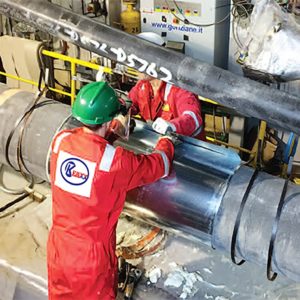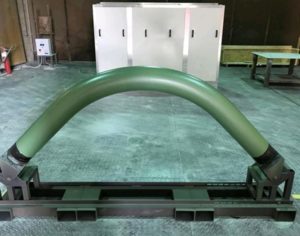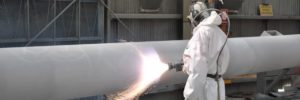
FIELD JOINT COATINGS
INJECTION MOLDED POLYPROPYLENE (IMPP):
Kemxx Nigeria limited have over the years of operation worked and developed on IMPP system to protect the onshore/offshore pipeline against corrosion and extreme temperatures to prevent cold spots, cracks and failures.
FIELD JOINT COATINGS
The field joint is the bare steel area where two pipe sections meet and are welded together. Offshore pipelines and subsea production structures have thousands of field joints that need protection against corrosion and extreme weather. Quality field joint coating systems not only protect against corrosion prone areas and cold spots but also offer the following:
- Long-term anti-corrosion and thermal insulation performance
- Excellent bonding to the steel substrate
- Compatibility with the parent coating system applied on the pipe joints
- Easy application and installation in any conditions and locations
- Short application and installation cycle time

INJECTION MOLDED POLYURETHANE (IMPU):
kemxx’s specializes in multi-layer anticorrosion systems, designed and application in a wide range of thicknesses and layers to meet insulation and subsea installation requirements. Linepipe coating is applied by side extrusion and is completed by the KEMXX advanced PP Injection Molding technology for field joints.
This world-class, reliable technology provides integral protection and an excellent interface between the parent linepipe coating and the field joint infill, and is suitable for reeling, J-lay and S-lay installation.
INJECTION MOLDING
Field joint coating services involve the coating of the girth welds produced on board the pipe-laying vessels or at any offshore location. KEMXX carries out the engineering, design and fabrication of customized field joint coating equipment.

FLAME SPRAYED POLYETHYLENE/POLYPROPYLENE (FSPE/FSPP):
In order to provide a totally compatible field joint coating system for 3-layer polypropylene- or polyethylene-coated pipelines, KEMXX has refined the process of applying PP or PE powder through the flame spray technique.
Powder is carried in a stream of air and is fed into the center of an annular combustion flame where it is heated. A second outer annular nozzle feeds a stream of air, around the powder stream, which accelerates the spray particles toward the substrate and prevents burning of the powder.
The system uses existing equipment for abrasive blasting/surface preparation and application of Fusion Bonded Epoxy (FBE) plus chemically modified polypropylene or polyethylene (CMPP or CMPE) dual-powder base layers. The overall thickness required is then achieved by applying powder with a flame spray gun.
The flame spray field joint coating system provides a full 3-layer system, which is highly adjustable to field conditions where coating thicknesses of up to 5mm are required.
The flame spray system can also provide a useful service for tie-ins or serve as a backup for a polypropylene or polyethylene Fused Field Joint (FFJ) system as well as being a thoroughbred field joint coating system in itself.
KEMXX’s polypropylene flame spray system has an extensive track record of use on onshore and offshore pipelines, as well as in spoolbases.

HEAT SHRINKABLE SLEEVE (HSS):
Corrosion protection in offshore and onshore applications with a variety of products.
CORROSION PROTECTION HEAT-SHRINKABLE SLEEVES IN ANY LOCATION YOU REQUIRE
For more than 5 years, KEMXX has been a leading specialist of specialty pipeline coatings for the sealing and corrosion protection of pipeline joints and other substrates. We can provide our heat-shrinkable sleeve systems offshore on pipelaying vessels or onshore on spoolbases and in any other locations needed.

FUSION BONDED EPOXY (FBE):
KEMXX has developed a range of service solutions for the efficient application of powder-applied coatings to the welded field joint area, supported by many years of experience.
Fusion Bonded Epoxy (FBE) powder coatings are applied to the welded joint area as a standalone coating system for FBE-coated pipelines or as a primer layer as part of multi-layer polyolefin field joint coating systems for multi-layer polyolefin-coated pipelines.
FBE application solutions and services to welded field joints include:
Semi-automated powder application equipment and services
Fully automated, combined heat-and-coat, powder application equipment and services
Key FBE Features
- Controlled thickness
- Efficient application cycle times
- Reduced waste and hazards to the environment
KEMXX strives to meet the highest levels of quality while maintaining the highest levels of productivity in the firing line. Our specialist technicians are trained in all disciplines and the operation of KEMXX application equipment.
FBE Application
The application of FBE powder coatings involves pre-heating the substrate to the required temperature (typically 240°C) by use of induction coils, followed by application of the powder coating.
KEMXX offers powder coating application services.
Semi-Automated Powder Application Equipment and Services
KEMXX has many years of experience in the application of powder coatings, using our semi-automated equipment and processes in the firing line. Our semi-automatic powder application equipment is available for a wide range of pipeline diameters.
KEMXX’s semi-automated powder coating equipment rotates around the field joint area in cycles to achieve the desired dry film thickness (DFT). These units are also used for the application of FBE and polyolefin adhesive as part of multi-layer systems (the FBE and polyolefin adhesive are interlocked together).
Fully Automated Powder Application Equipment and Services
In response to the industry, for optimum cycle times and high repeatability, KEMXX developed the RAPTOR heat-and-coat machine.
RAPTOR units are fully automated, designed to simultaneously pre-heat and apply powder coatings to the field joint area in high-production environments such as spoolbase operations, multi-jointing activities, offshore lay barges, and onshore pipeline construction.
The units are fully contained, offering the highest levels of HSE protection to the environment and operator. RAPTOR units are also used for the application of FBE and polyolefin adhesive as part of multi-layer systems (the FBE and polyolefin adhesive are interlocked together).

THERMALLY SPRAYED ALUMINIUM (TSA):
- Thermal sprayed aluminium (TSA) coatings are widely specified for the protection of steels from aqueous corrosion in seawater environment e.g. offshore structures, risers, pipe components and ship structures.
- The main service conditions for the application of TSA include seawater immersion, tidal and splash zone and marine atmosphere.
- The successful use of TSA coatings in offshore applications such as tension leg elements and production risers in deep seawater have been reported in the literature.
- Toughness, low maintenance requirements, and long-term service life are among the desirable properties offered by TSA coatings for offshore applications.
- The basic properties of a TSA coating for long-term service are its barrier characteristics combined with good adhesion and an ability to provide cathodic protection to exposed steel. It was reported that a 200µm thickness TSA coating would provide a service life in excess of 30 years in a splash zone environment if optimised.
- Key factors for optimisation include TSA alloy composition; surface preparation; choice and application of a sealer; service application; electrochemical/galvanic exposure conditions; coating application techniques and process parameters. The stringent requirement of the offshore industries (e.g. oil and gas) to have a maintenance free coating system, with an expectation of up to 50 years life in severe environments, has increased interest in TSA coatings viable economic alternative to paint based systems.
- Although it has been demonstrated that TSA deposited by conventional spray systems can work well over extended periods, incidents of premature coating failure due to blistering and detachment have been recorded, indicating that coating quality and coating application procedure is extremely important.
- Porosity, oxide content and non-uniformity in the TSA coatings produced by the conventional systems are believed to result in reduced corrosion protection and shorter lifetime. Recent developments in spraying equipment via modification in nozzle and gun design, and process parameters (such as higher gas flow rates and gas pressures) are believed to produce TSA coatings with improved properties.
